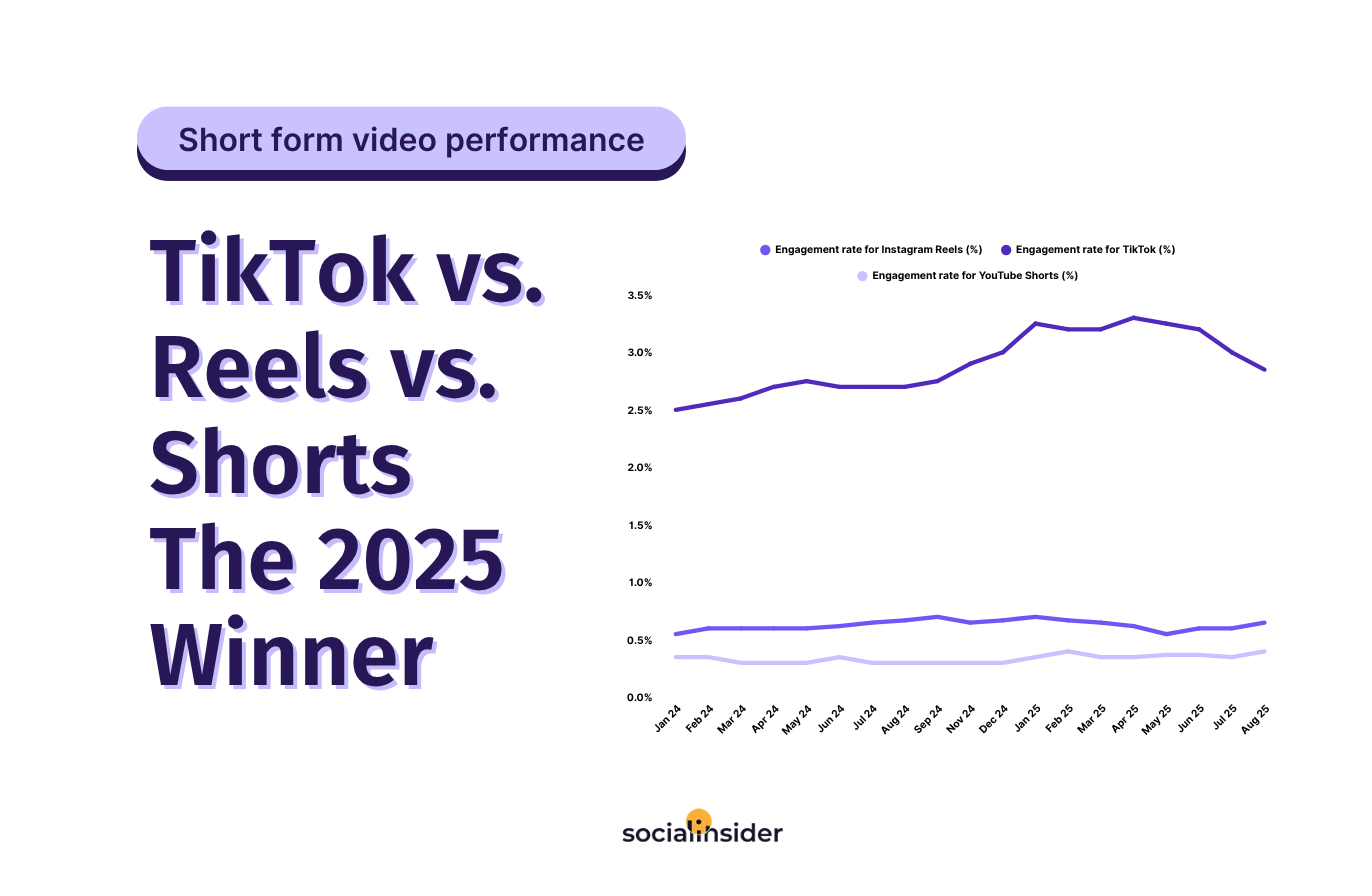[What Data Says] How Many Social Media Interactions Does Every Platform Drive
Do you know how many social media interactions every platform drives? Discover what networks work best to help you connect with your audience.
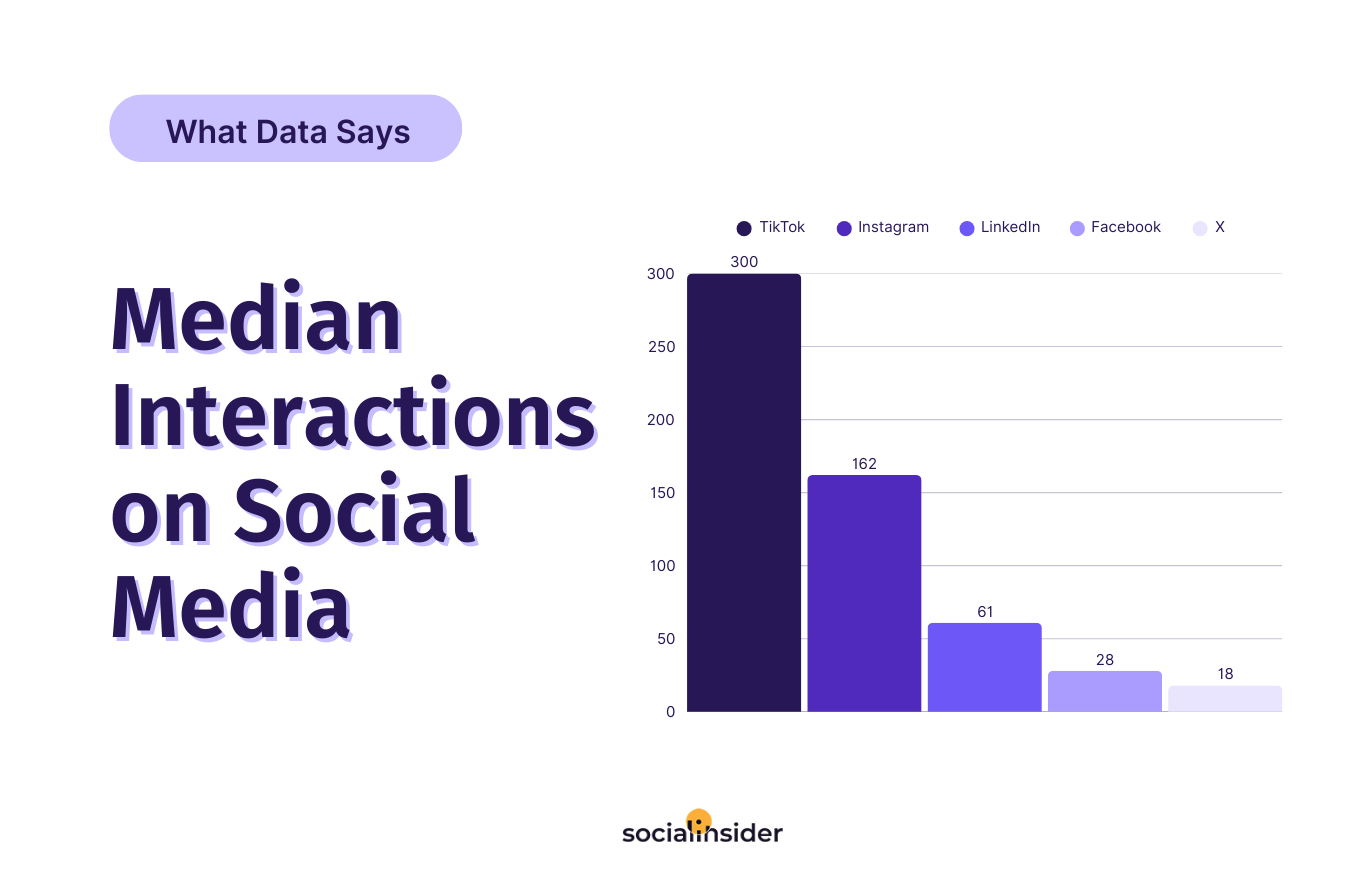
If your social media feels like shouting into the void, you're not alone. Posting content is easy—boosting social media interaction? That’s the real challenge.
The secret isn’t just in what you post, but how you encourage different types of social media interactions. Comments, shares, reactions—each plays a role in improving your social media strategy.
With the help of social media analytics and data, you can understand what tactics are most effective for boosting your social media presence.
Below, you'll find a couple of social media interaction benchmarks across platforms that will help you understand just how successful your current approach is. Let's dive in!
Key takeaways
Interactions on TikTok have increased by 42% year-on-year, while on Instagram they have risen by 20%, and on LinkedIn by 42%. However, Facebook has seen a decrease of 47%.
In 2025, the social media interactions across platforms are:
- TikTok: 300 interactions per post
- Instagram: 162 interactions per post
- LinkedIn: 61 interactions per post
- Facebook: 28 interactions per post
- X: 18 interactions per post
What do social media interactions stand for?
Social media interaction refers to any action a user takes when engaging with a brand’s profile or content. This goes beyond just liking a post—it includes direct messages (DMs), mentions, tags, and any other touchpoints a user actively connects with you on social platforms.
Interaction vs. engagement
People often club "interaction" and "engagement" together, but they’re not the same thing.
- Interactions are direct, intentional actions—sending a DM, tagging your brand in a post, or mentioning you in a comment. They represent a user reaching out to you, not just reacting to content.
- Engagement is broader and includes likes, shares, and comments. It’s a sign people find your content interesting, but it doesn’t always mean they’re invested in your brand.
All social media engagement is interaction, but not all interactions are engagement. If you want to build real relationships, focus on interactions that go beyond vanity brand metrics.
Types of social media interactions
Let’s take some social media interaction examples, such as like comments or shares— they are loud and obvious. Others happen quietly in the background like someone bookmarking a post or watching a story without reacting. All of them matter.
You need to understand the different social media interaction types and tailor your strategy accordingly.
Direct interactions
Some actions on social media take zero effort—scroll, tap, move on. But direct interactions? Those show intent, indicating deeper interest and creating opportunities for a direct relationship start.
Following
A follow is a sign of ongoing interest. Unlike a casual like or share, a follow suggests a longer-term commitment, making these users more likely to interact with your brand's social media content.
Likes and reactions
A like might be the easiest way to interact with content, but that doesn’t make it meaningless. It’s a quick nod of approval. Think of it as a digital “this caught my eye.”
Some platforms, like Facebook and LinkedIn, offer multiple reaction options—love, laughter, anger—giving brands insight into not just whether content resonates, but how it does. A flood of “wow” reactions? You’ve sparked curiosity. An unexpected wave of angry faces? Time to dig into what’s not landing right.
Comments and replies
Whether it’s a genuine question, a strong opinion, or a simple tag to a friend, comments and replies create a two-way dialogue. And when brands respond? That’s what counts the most. A quick reply or acknowledgment makes your audience feel heard, which encourages further interactions.
Shares and retweets
Sharing content is one of the most valuable social media brand interactions. When someone shares a post on their feed, retweets on X, or reposts on Instagram, they’re endorsing the content to their own audience. This kind of organic social amplification exposes your brand to new potential followers without you spending a dime.
Story engagement (polls, emoji reactions, etc.)
Social media stories offer unique interactive elements. Users can:
- participate in polls
- respond to Q&A stickers
- send quick emoji reactions
Moreover, the temporary nature of stories adds urgency, nudging users to engage before the content disappears. And because these audience interactions on social media are lightweight and easy, they’re often the most authentic indicators of audience interest.
Direct messages
DMs allow users to have private 1:1 conversations with brands. Whether it's a customer inquiry or service request, this type of brand interactions on social media creates direct communication channels. Fast, thoughtful responses here can really strengthen customer relationships.
Indirect interactions
Sometimes, users talk about you without directly engaging with your content. These indirect interactions shape your reputation and visibility, whether you’re part of the conversation or not.
Mentions and tags
A mention is when someone references your brand in a post, comment, or reply. It could be praise, criticism, or just a casual nod—either way, it puts your name in front of their audience. Mentions don’t always come with a clickable link, but they still contribute to brand awareness.
A tag, on the other hand, directly links to a brand’s profile. When users tag your profile in a post, they want your attention—maybe to highlight a great experience, call out a frustration, or enter a contest. Because tagged content often lands in your notifications, you can jump in and engage with users in real-time.
Reviews and ratings
A glowing review can be as persuasive as a well-crafted ad. A bad one? Even more influential.
Platforms like Facebook and Google give users a place to rate businesses and share their experiences, shaping how potential customers see you. Positive reviews build trust, while negative ones—if handled well—can showcase your commitment to customer service.
Passive interactions
Passive interactions are subtle but valuable. They indicate interest in your content or brand, even if users don’t directly engage with your posts. While they don’t involve explicit actions like comments or shares, they still contribute to overall brand awareness and audience insights.
Profile visits
A user lands on your profile, scrolls through your content, and then leaves without engaging. What does that mean? It could signal curiosity, but if visits are high and engagement is low, something’s off. Maybe your bio isn’t compelling or your posts aren’t converting interest into action.
Post views and impressions
Post views refer to the number of times an individual user has seen your content. Whereas, impressions measure how many times your content appears on someone’s feed—even if the same user scrolls past it multiple times.
A post with soaring impressions but little engagement? That’s a sign it needs a stronger hook, more striking visuals, or a clearer next step for your audience.
Saves
A save occurs when a user bookmarks a post for future reference, signaling strong content value. While saves don’t generate immediate engagement (compared to getting interactions on posts—likes or comments), they indicate deeper interest.
Moreover, platforms like Instagram prioritize saved posts in their algorithm, so they're now an important social media metric to measure social content performance.
Transactional interactions
Transactional interactions are user actions that go beyond engagement and directly contribute to business objectives. These interactions indicate a user’s intent to move down the funnel, which makes them highly valuable if you're focused on conversions.
Link clicks
Whether it’s a link in an Instagram bio, a swipe-up in a story, or a button leading to a product page, clicking on a link means they’re taking a step toward action. These clicks signal curiosity and potential intent to buy, subscribe, or engage further.
Purchases via Social Commerce
Instagram, Facebook, and TikTok have built-in shopping features, turning casual browsing into instant sales. A “Buy Now” button or an in-app checkout removes friction, so it's easier than ever for users to purchase without leaving their feed.
Sign-ups (e.g., Webinars, Newsletters, Free Trials)
When someone signs up for a webinar or grabs a free trial from social media, they’re doing more than just following a brand—they’re opting in. These interactions open the door to deeper engagement, giving you a chance to turn interest into long-term relationships.
Why track social media interactions?
Every, comment, share, or DM is a window into what people think about your brand. Ignoring these signals means missing out on key insights that can refine your social media marketing strategy and ultimately drive results.
Signals the level of interest in your brand
If a post racks up thousands of views but barely any likes or comments, it’s a sign your content could use some optimization for increased interactions and interest from your viewers. On the other hand, if people are consistently tagging friends, replying to your stories, and DMing you, you’re building an engaged community.
Enables content strategy optimization
You could keep guessing what works, or you could let the data tell you. Track social media interactions to see what truly works. For instance:
- Are carousel posts getting saved and shared? Your audience probably likes in-depth content.
- Getting more DMs after posting Reels? Short-form videos are more likely to create stronger conversations.
- Struggling to get clicks on CTA-driven posts? It's time to refine messaging or experiment with new formats.
Identifies audience needs, struggles, and preferences
Every social media interaction is also a piece of feedback, whether direct or indirect. You can learn a lot from your target audience's interactions—what they care about, what annoys them, and what they expect from your brand.
- Seeing repeated complaints in DMs and comments? That’s a sign something—pricing, shipping, product quality—isn’t working.
- A random post about sustainability blew up? Your audience might care more about ethical business practices than you realized. Posts that spark meaningful discussions reveal what matters most to the audience.
- A product teaser gets way more engagement than others? That’s free market research on which offerings are most appealing to potential buyers.Instead of making assumptions, use these social media insights to adjust your messaging, refine your products, and double down on what actually resonates.
Helps evaluate other promotion strategies
Tracking social media interactions is also a key indicator of whether other promotional efforts are working. For example:
- Running Instagram Shop ads? Compare clicks on product tags and DMs asking about availability to actual sales.
- Partnering with influencers? Look beyond impressions—are their followers actually engaging with your brand?
- Testing a new direct shopping feature (like TikTok Shop)? See if users are adding products to their cart or just browsing and bouncing.
If people are clicking but not converting, there’s a disconnect somewhere—maybe in your checkout process, pricing, or product messaging. Engagement data helps you find the weak links.
Enhances positive brand experiences
People expect brands to be responsive, and the ones that engage in real-time build deeper trust. Consider the following:
- Quick responses to DMs and comments improve customer experience and reduce frustration.
- Proactively addressing brand mentions (both positive and negative) shows that a brand listens and cares.
- Acknowledging loyal customers (e.g., resharing user-generated content or engaging with repeat commenters) strengthens brand relationships.
Social media interaction benchmarks across channels
Every social media platform fosters different types of interactions, influenced by its unique features and user behavior.
Understanding benchmark interaction metrics across channels lets you set realistic expectations and do social media optimization effectively.
Interactions on TikTok have increased by 42% year-on-year, while on Instagram they have risen by 20%, and on LinkedIn by 42%. However, Facebook has seen a decrease of 47%.
In 2025, the interactions for organic content on social media across platforms are:
- TiTok - 300 median interactions
- Instagram - 162 median interactions
- LinkedIn - 61 median interactions
- Facebook - 28 median interactions
- X (formerly Twitter) - 18 median interactions
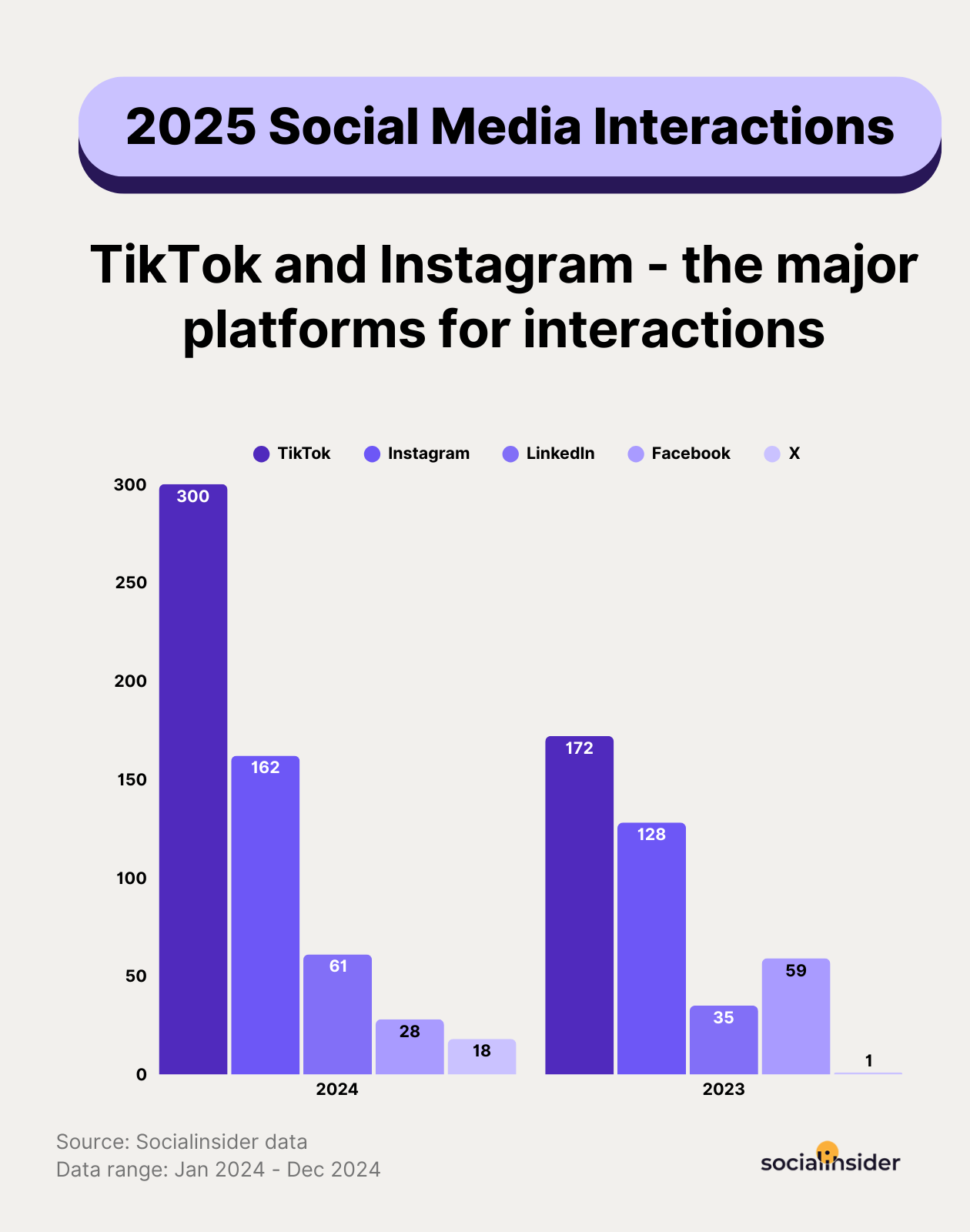
Median interactions on LinkedIn
LinkedIn interactions include:
- Reactions (Like, Celebrate, Support, Love, Insightful, Curious);
- Comments;
- Shares;
- Poll votes;
- Clicks on links and documents;
- Follows and connection requests.
While on LinkedIn the median number of interactions per post is 61, native documents and multi-image posts stand out, performing exceptionally well, significantly exceeding this benchmark.
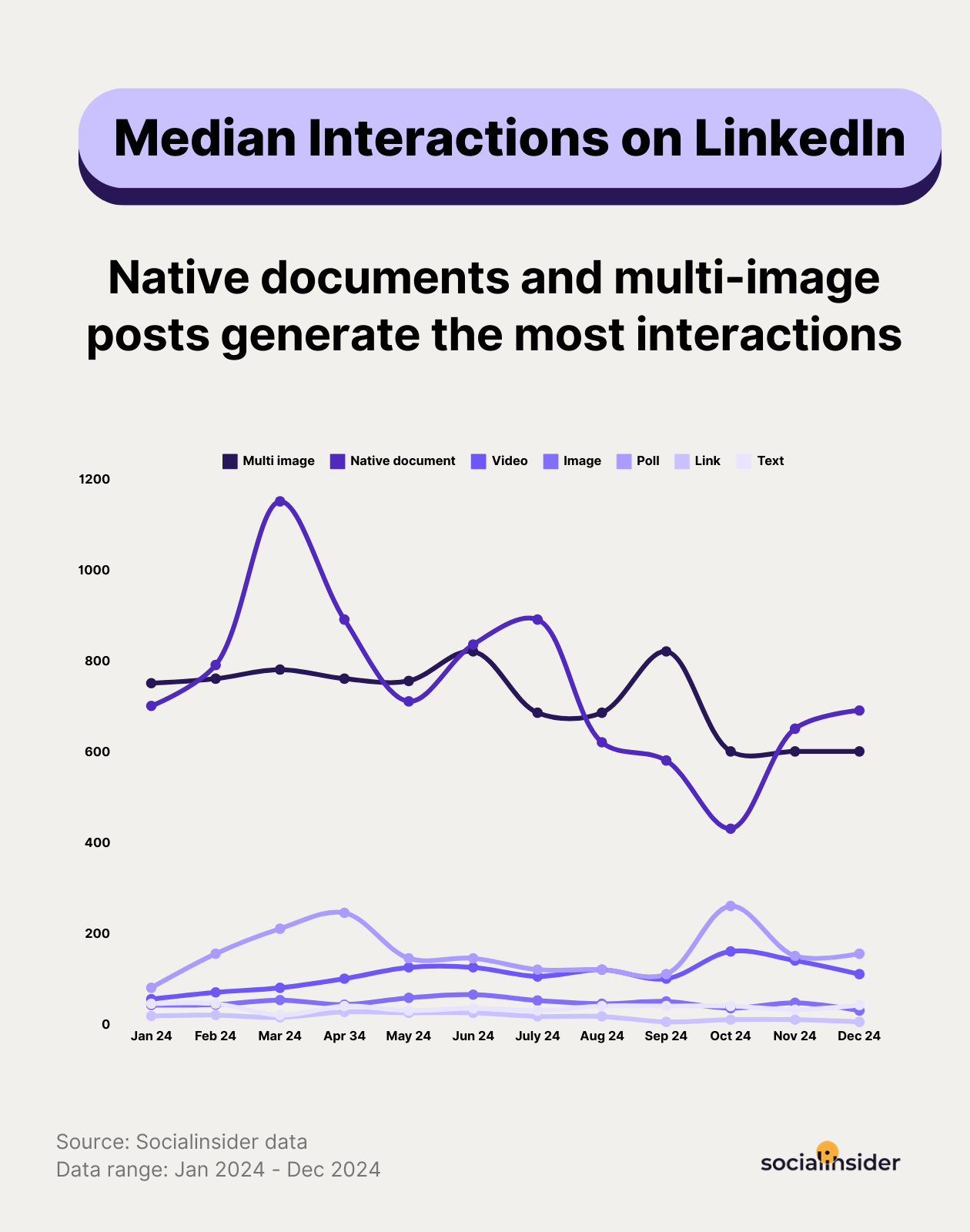
You can think of it his way: on LinkedIn, whitepapers, reports, and guides are a goldmine, and these formats are the best at portraying in-depth information in a digestible format.
In contrast, single images, articles, and plain text posts struggle, suggesting LinkedIn’s algorithm and audience now favor interactive, resource-driven content.
Based on Socialinsider data, we track the median interactions on LinkedIn for the most active pages, with followers between 1k and 1M. Through the API, when measuring the interactions on LinkedIn, we included the following data:
- likes
- comments
- shares
Median interactions on TikTok
TikTok interactions include:
- Likes;
- Comments;
- Shares;
- Saves (favorites);
- Duets and stitches;
- Profile visits and follows.
On TikTok, the median interactions hovers around 300, but performance isn’t uniform across content types. When it comes to interactions, videos lead the pack, outperforming carousels throughout the year.
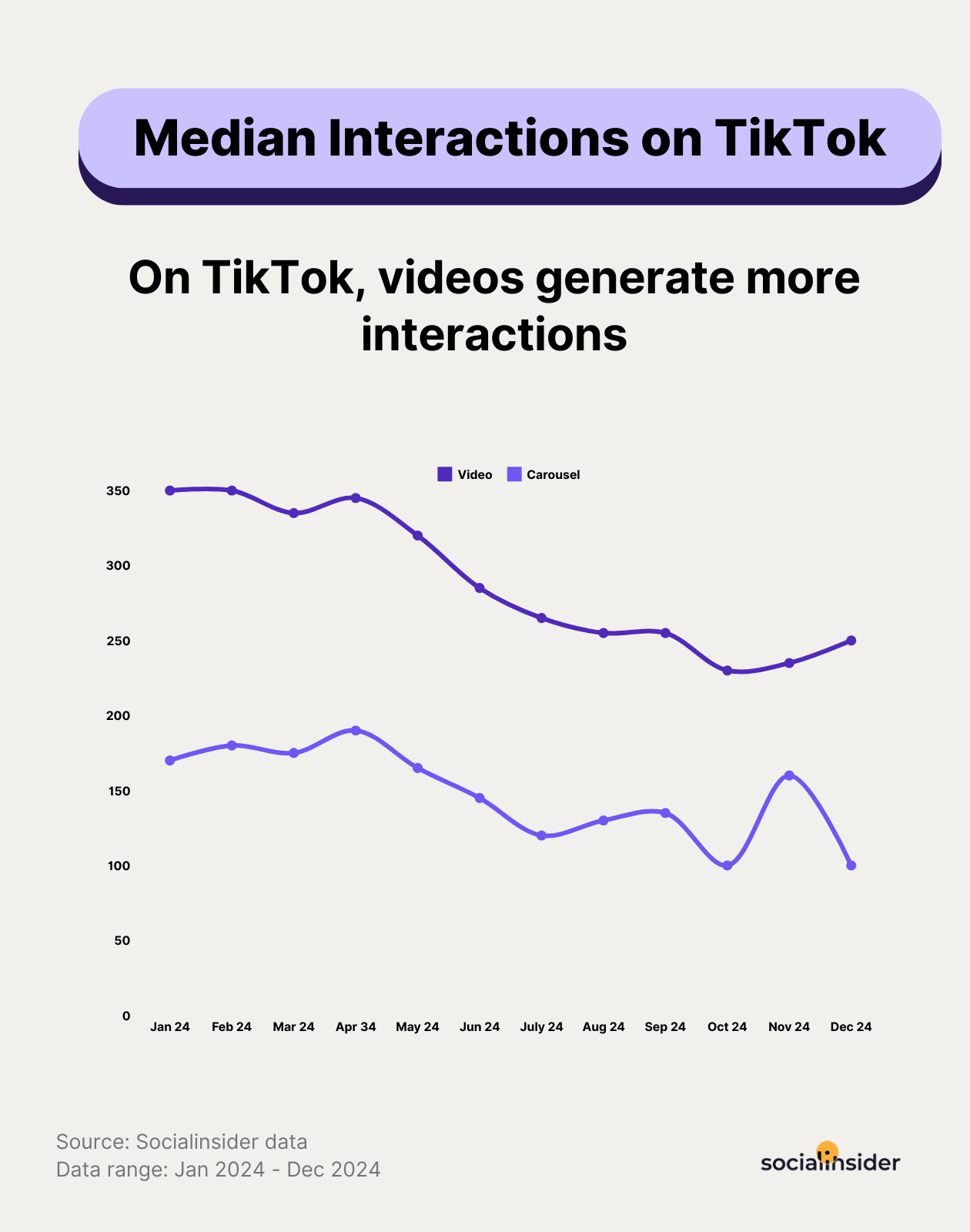
Based on Socialinsider data, we track the median interactions on TikTok for the most active pages, with followers between 1k and 1M. Through the API, when measuring the interactions on LinkedIn, we included the following data:
- likes
- comments
- shares
Median interactions on Instagram
Instagram interactions include:
- Likes;
- Comments;
- Shares;
- Saves;
- Profile visits and follows;
- Story replies and poll interactions.
Instagram scores an 162 median interactions per post, post Carouosels being the top-performing post format when it comes to generating audience interest.
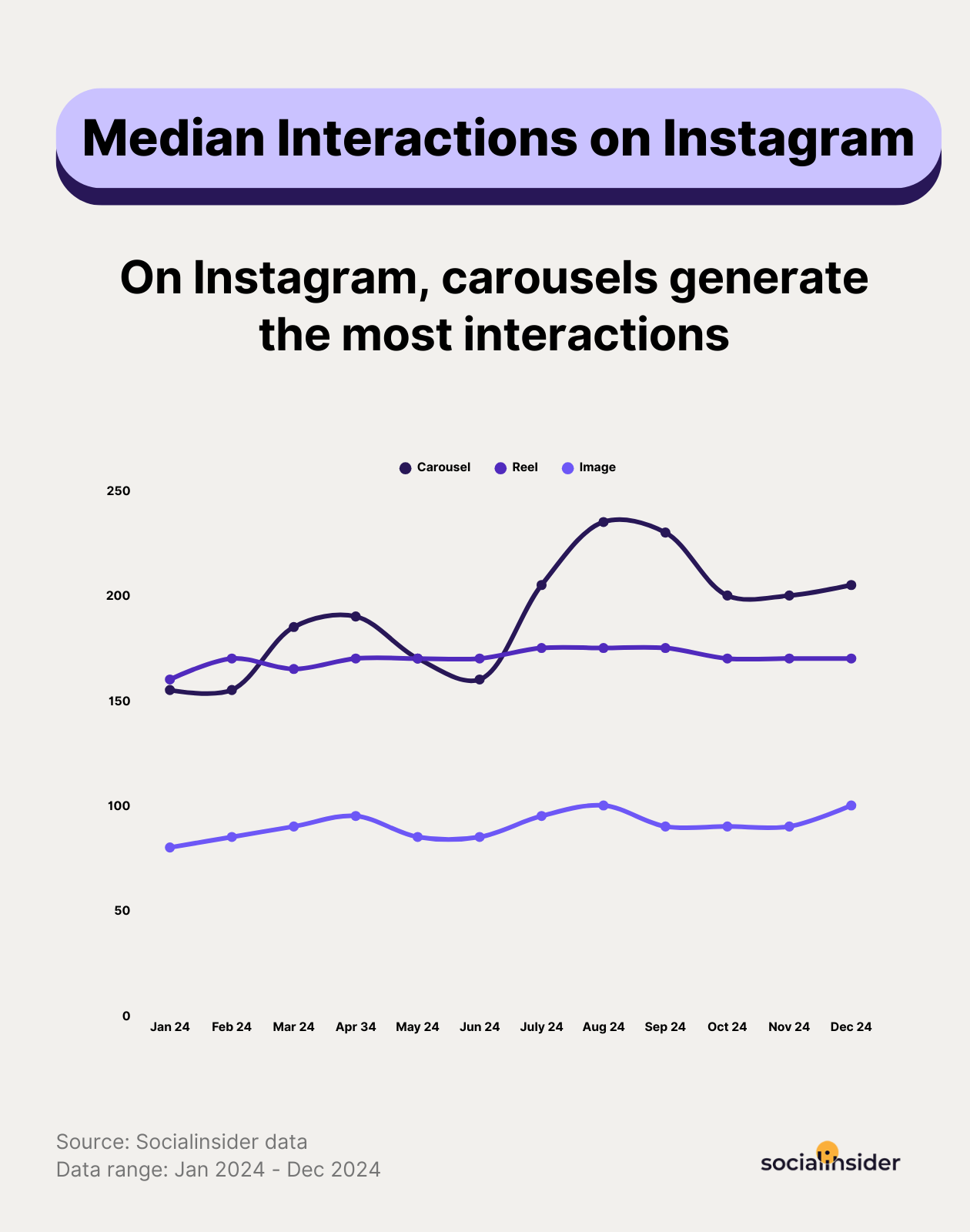
Naturally, this is due to Carousels's highly storytelling nature, this particular type of post being designed with the specific thought of making users spend more time, scrolling through its multiple slides to get the complete information they look for.
Based on Socialinsider data, we track the median interactions on Instagram for the most active pages, with followers between 1k and 1M. Through the API, when measuring the interactions on LinkedIn, we included the following data:
- likes
- comments
Median interactions on Facebook
- Reactions (Like, Love, Haha, Wow, Sad, Angry);
- Comments;
- Shares;
- Link clicks;
- Photo/Album views;
- Reels views;
- Status replies.
Facebook might still be massive, but engagement? Not so much.
On Facebook, the median interactions per post is 28—far lower than platforms like TikTok or Instagram. And when you break it down, the biggest surprise is this: text-based status updates consistently outperform everything else.
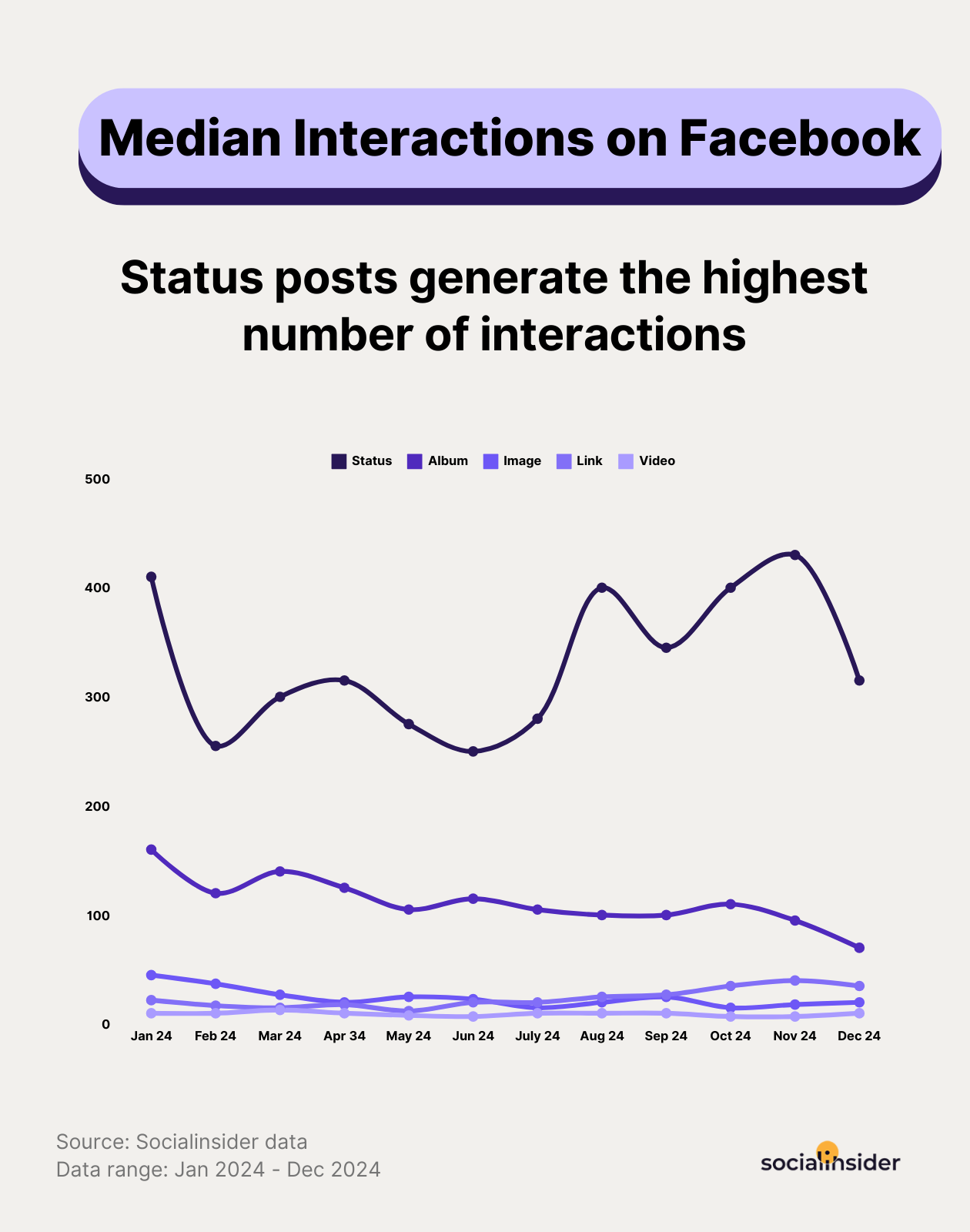
Users engage most with discussions, personal updates, and opinion-sharing, rather than clicking on links or watching videos. Grouped photo albums come in second but trail far behind status updates, suggesting that while visual content still draws attention, it doesn’t spark conversation the same way text does.
All in all, the trend is clear—unless a post invites discussion, it’s likely to get lost in the feed.
Based on Socialinsider data, we track the median interactions on Facebook for the most active pages, with followers between 1k and 1M. Through the API, when measuring the interactions on LinkedIn, we included the following data:
- likes
- other reactions
- comments
- shares
Median interactions on X (formerly Twitter)
- Likes;
- Replies;
- Reposts (Retweets);
- Quote posts;
- Link clicks;
- Media views;
- Profile clicks.
On X, the median interactions sits at 18, a modest number compared to platforms like TikTok or LinkedIn, where engagement tends to be higher. The standout performer? Video.
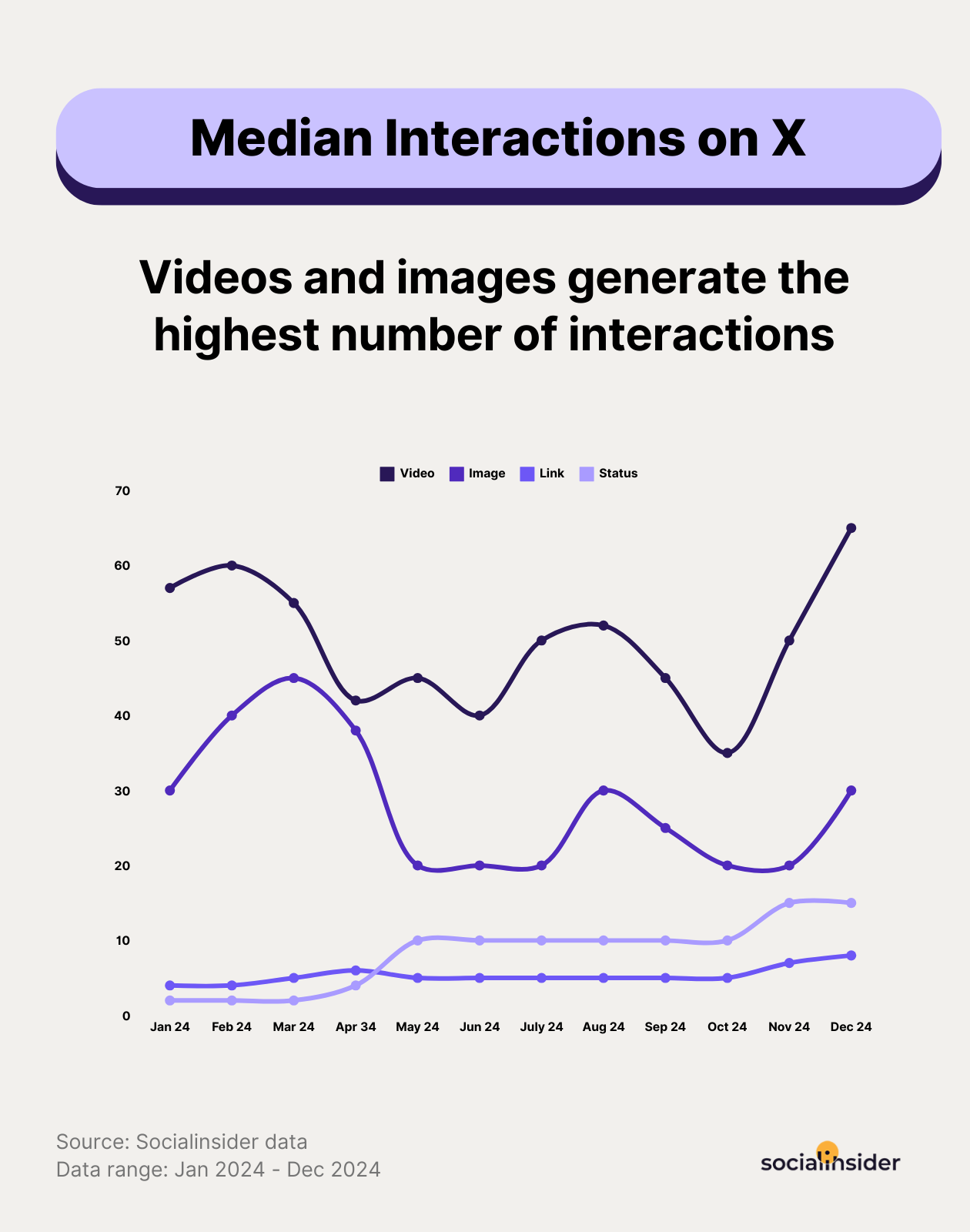
Moving visuals dominate, consistently drawing the most interactions. Static images follow but have been losing ground, hinting at a shift in user preference.
Based on Socialinsider data, we track the median interactions on X for the most active pages, with followers between 1k and 1M. Through the API, when measuring the interactions on LinkedIn, we included the following data:
- replies
- retweets
How to increase audience interactions on social media?
To truly increase interactions, you need to go beyond traditional content formats and tap into human psychology, social behaviors, and interactive elements that encourage participation. Here’s how:
Leverage conversational content (invite followers to share opinions)
Social media is inherently social, yet many brands treat it as a one-way broadcast channel instead of a platform for genuine conversation. Your social posts should invite responses and spark discussion.
Here are a few ideas to get you by:
Ask open-ended questions
Instead of generic announcements, ask something that sparks opinions. For example:
❌ “We just launched a new product!” (No interaction incentive)
✅ “What’s the one feature you wish brands included in [product type]?” (Encourages interacting with a brand on social media)
Use quick-response polls
Quick, low-effort polls (think: “This or That” and “Agree or Disagree” polls) drive higher engagement because users can participate in seconds, without having to write a full response.
Respond to comments to extend conversations.
If someone comments, don’t leave them hanging. Acknowledge them, ask follow-ups, or challenge their take to turn a one-time reply into an ongoing discussion.
Create emotional triggers
Posts that rack up the most likes, shares, and comments hit. They trigger emotions that make people stop scrolling and engage. Excitement, nostalgia, inspiration, FOMO—whatever the feeling, it needs to be strong enough to make people react.
Here’s how to craft posts that do exactly that:
- Tap into nostalgia. People love revisiting the past—especially when it comes to childhood, trends, or pop culture moments. For example, I bet that a gaming brand asking, “What was the first video game you ever played?” will instantly spark a flood of memories in the comments.
- Make it funny (and painfully relatable). Humor works because people share what makes them laugh. A coffee brand posting, “Me after my first cup of coffee vs. before” with a dramatic before-and-after image? That’s getting tagged and reshared.
- Create FOMO. No one likes to miss out. Limited-time deals, exclusive drops, or early access offers can trigger instant action. If people think “I need this before it’s gone,” you’ve won.
- Inspire people. Success stories, personal transformations, and behind-the-scenes struggles make audiences connect. A fitness brand showing a customer’s real progress? That’s engagement gold—especially when others jump in to share their own stories.
Use interactive features
Social media platforms reward engagement, and interactive features make it easy for users to participate without much effort. The more people interact with your posts, the more visibility they get—simple as that.
Here’s how to make your content more engaging with interactive tools:
- Polls (Instagram, Facebook, LinkedIn): A tap is all it takes for users to share their opinion. Great for quick insights or playful engagement.
- Q&A and open-ended questions (Instagram Stories, LinkedIn, X): Invite real conversations and spark discussions without forcing users to type full responses.
- ‘Ask Me Anything’ (AMA) sessions: Use Instagram Stories or X to answer audience questions in real-time, making your brand feel more approachable.
- Quizzes and voting features (Instagram quiz stickers, LinkedIn polls): Turn knowledge-sharing into a game to boost participation.
Integrate AR filters to offer immersive virtual experiences
With platforms like Instagram, TikTok, and Snapchat offering built-in AR tools, the real challenge isn’t adding AR to your social media strategy—it’s using it in a way that actually matters.
Here are some ideas:
- Virtual product demos: Give prospects a hands-on feel before the demo call. A B2B SaaS company could use AR to visualize real-time social media analytics, letting users explore key platform features with a simple phone scan, turning abstract data into something they can interact with.
- Gamified assessments: Make lead generation feel less like a pitch and more like an experience. A recruitment tech company could launch an AR-powered “resume red flag” scanner, where users upload their CVs to see AI-generated insights—giving them a taste of the platform’s capabilities in seconds.
- Industry-specific AR experiences: Simplify the complex. A manufacturing firm could create an AR tool that overlays real-time machine diagnostics on industrial equipment. Prospects can then see exactly how their predictive maintenance software works.
Augmented reality filters aren’t just for consumer brands trying to go viral. Used strategically, they give potential customers an experience they actually want to engage with. The brands that use it to bridge the gap between “tell” and “show” will stand out—not just for novelty, but for impact.
Post content tailored to your audience’s interests and preferences
Not all social platforms work the same way, and neither should your social media content strategy. To get real engagement, you need to understand what each platform’s audience actually responds to.
TikTok and Instagram are built for short-form videos, trends, and interactive stories, while LinkedIn thrives on thought leadership, industry insights, and document-based content.
On X (Twitter), quick, text-driven conversations, polls, and trending topics drive interactions.
Facebook leans into nostalgia, discussions, and long-form community engagement.
If you’re posting the same content everywhere, you’re likely missing opportunities for better reach and engagement.
Luckily, with Socialinsider's Content Pillars Analysis feature you can easily identity the best performing topic on each platform and optimize your posting strategy accordingly.
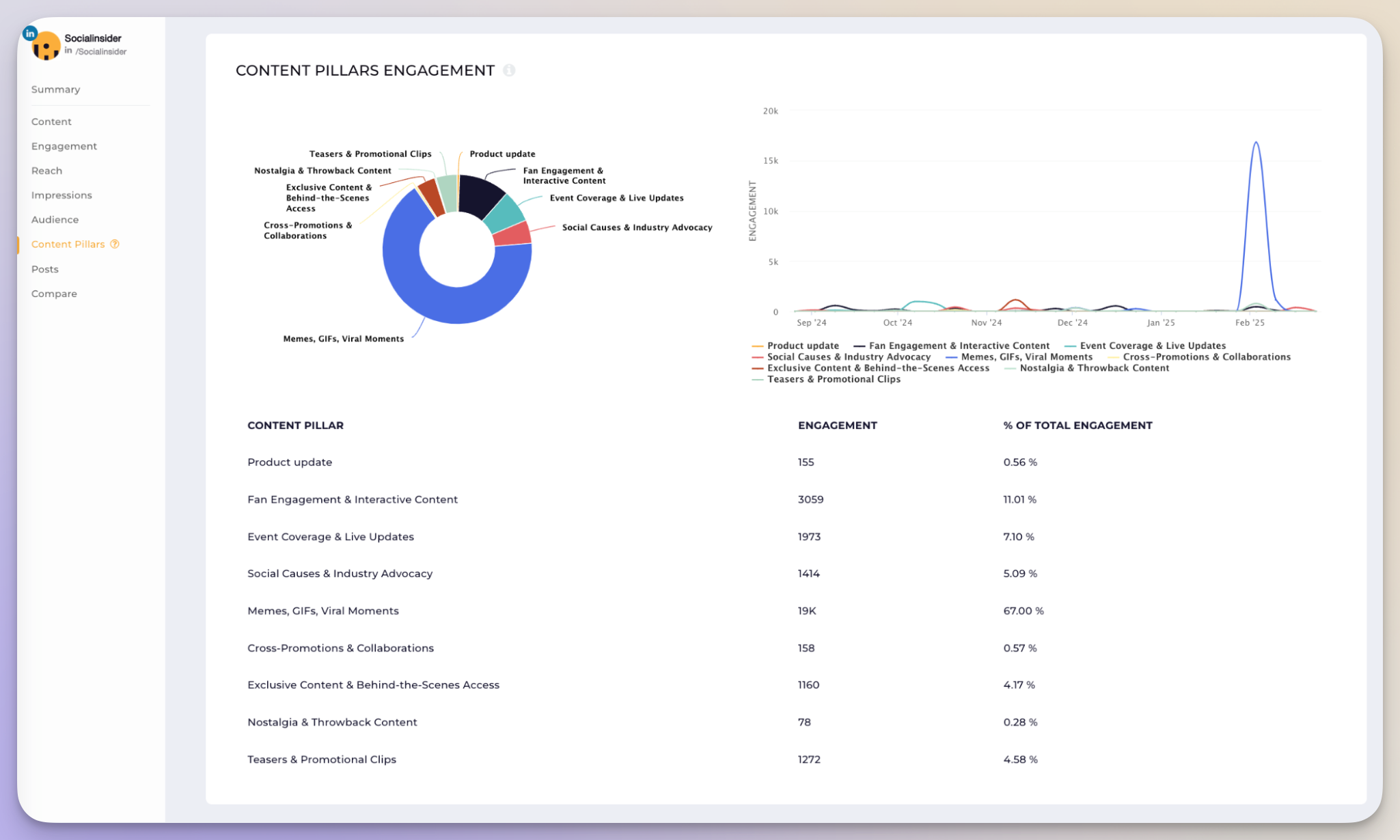
And btw, format matters just as much as content.
To create a top-notch strategy, we recommended pairing the best-performing themes with the most engaging formats.
Then, sit back, relax, and watch the magic happen. Just kidding (partially). Tracking your data should be an ongoing process, one that will help you stay on top of algorithmic and market trend changes.
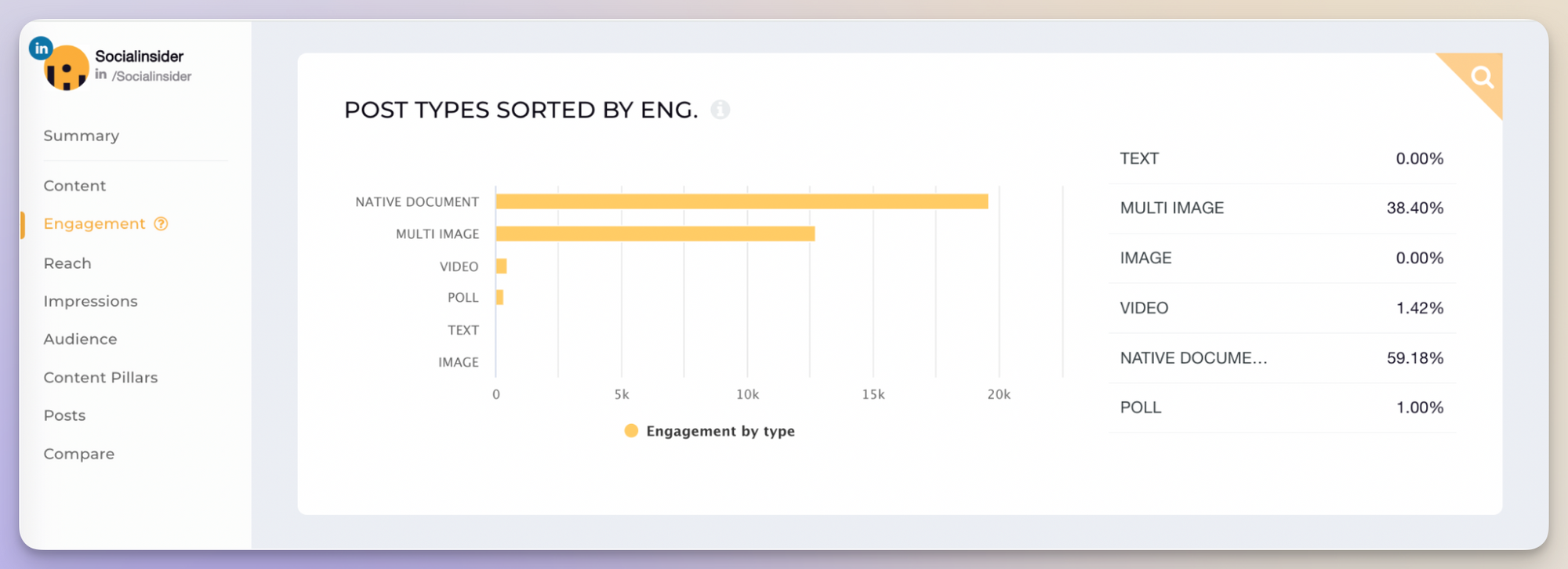
Rather than guessing, track engagement trends and adjust accordingly. If short-form videos are winning on Instagram, keep creating them. If LinkedIn users engage more with in-depth reports, focus on those. Every platform provides clear signals on what works best—you just need to listen.
Organize challenges and contests
A well-planned challenge or contest does more than just boost engagement—it gives people a reason to interact with your brand. The best ones feel effortless to join and rewarding enough to share, turning casual followers into active participants.
For example, a branded hashtag challenge can encourage user-generated content, making your audience part of the conversation instead of just spectators.
A comment-to-win contest creates direct engagement, drawing people into your posts.
Want to push visibility further? Partnering with influencers or complementary brands can introduce your challenge to new audiences while keeping it fresh.
The key is to design something people want to participate in—not just another giveaway they scroll past.
Methodology
The findings of this study are based on the analysis of X, Facebook, Instagram, TikTok, and LinkedIn social media posts published between January 2024 - December 2024.
Median interactions = the midpoint value for social media interactions. By calculating the median (instead of the average), we make sure we filter out the outlying values that are skewing the results.
Analyze your competitors in seconds
Track & analyze your competitors and get top social media metrics and more!
You might also like
Improve your social media strategy with Socialinsider!
Use in-depth data to measure your social accounts’ performance, analyze competitors, and gain insights to improve your strategy.

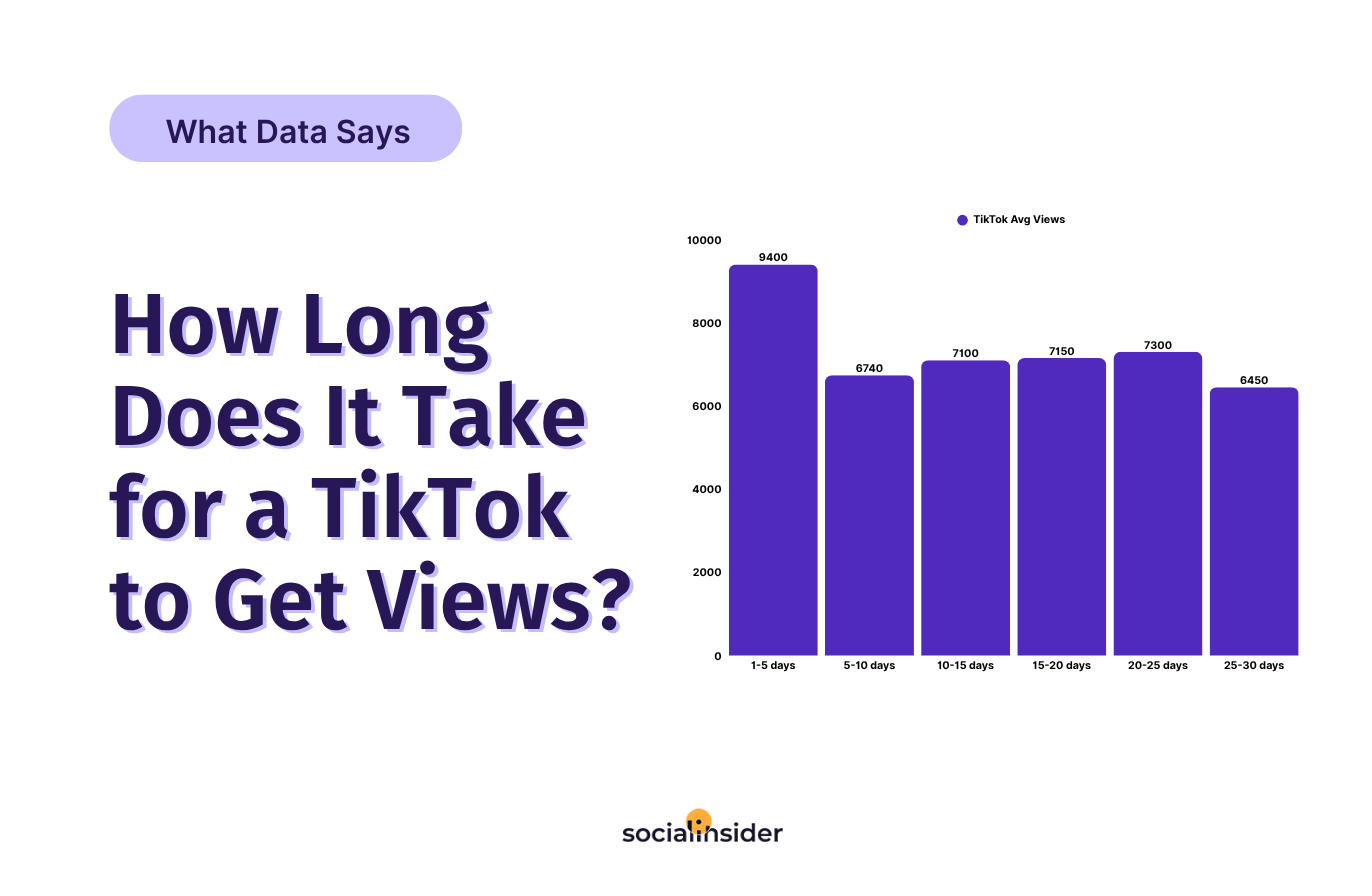

![[What Data Says] Zero-Click Content for Social Media](https://blog-cms.socialinsider.io/content/images/2025/10/zero-click-content-cover.png)
